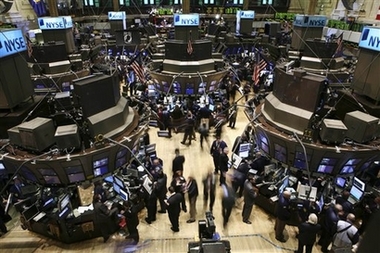Stocks rebound, but still end lower
(AP)Updated: 2007-03-02 08:46
NEW YORK - A still skittish Wall Street closed modestly lower Thursday, having clawed its way back from an early-session plunge after upbeat manufacturing data allayed fears about a flagging US economy.
Investors, relieved that manufacturing is still expanding, bought some of the stocks pummeled in Tuesday's drop, which sliced 416 points off the Dow. The blue chip index is now down 398 points, or 3.2 percent, from its closing level Monday, having rebounded halfheartedly Wednesday on calming words about the economy from Fed Chairman Ben Bernanke.
The ISM data helped the market regain lost ground, but anxiety still plagued the Street, with the indexes bouncing around choppily as many investors bailed out of equities and fled to safe havens like Treasurys, betting that stocks have further to fall.
"The aftermath of Tuesday's major selloff will linger for the next couple of days. I don't think we're totally out of the woods yet," said Peter Cardillo, chief market economist at New York-based brokerage house Avalon Partners Inc.
The Dow fell 34.29, or 0.28 percent, to 12,234.34, after dropping as low as 12,056.54 in the first hour of trading. It hasn't traded at these levels since early December.
Broader stock indicators also ended down after fluctuating in the afternoon. The Standard & Poor's 500 index fell 3.65, or 0.26 percent, to 1,403.17, after tumbling 26 points earlier in the day.
The technology-dominated Nasdaq composite index finished down 11.94, or 0.49 percent, at 2,404.21, following an earlier drop of 56 points.
Stocks plunged Tuesday amid escalating worries that the US and Chinese economies are slowing, exacerbated by a huge decline in Chinese stocks and comments from former Fed Chairman Alan Greenspan that a US recession is a possibility. A day later, they managed an anemic recovery as Bernanke predicted the US economy would continue to grow moderately.
The market appears to be trading in a pattern similar to past downturns: dropping sharply one day, regaining some ground the next and then resuming its slide, waffling due to investors' inability to recoup their lost conviction in stocks.
"The early morning hours raised the concern that we haven't hit our bottom yet," said Jack Caffrey, equities strategist at J.P. Morgan Private Bank. "It's probably going to be a grinding, sideways movement over the next few days as people realize there are risks out there."
Bond prices rose on weak stocks Thursday, pushing the yield on the benchmark 10-year Treasury note to 4.55 percent from 4.57 percent late Wednesday.
Gold prices fell, while the dollar rose against most major currencies, with the exception of the Japanese yen. The dollar has been losing ground to the yen, as traders unwind yen "carry trades" - borrowing the low-yielding yen to invest in the higher-yielding dollar, a technique that many market watchers say accelerated the US market's recent decline. The dollar traded at 117.59 yen at the stock market's close on Thursday, down from Wednesday's levels but up from an earlier low of 116.94.
US investors began the day rattled by another series of declines in Asian and European markets.
"It's kind of the tail wagging the dog today. There's no stability in Asian
markets, and no stability in European markets. We're trading the market as the
rest of the globe is," said Arthur Hogan, chief market analyst at Jefferies
& Co.
| 1 | 2 |  |
|
||
|
||
|
|



